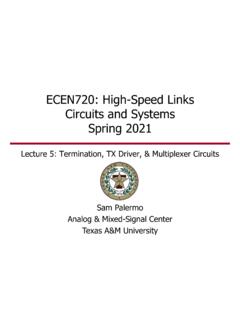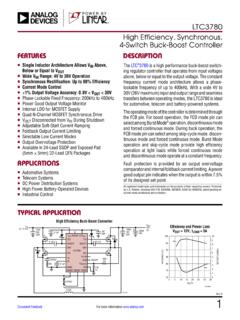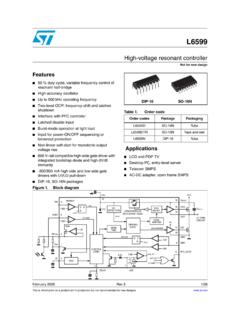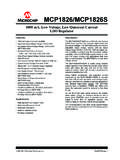Transcription of A Fortran Tutorial - University of Utah
1 A Fortran Tutorial 1. What is Fortran ? 2. Fortran basics 3. Variables, declarations, and types 4. Expressions and assignment 5. Logical expressions 6. The if statements 7. Loops 8. Arrays 9. Subprograms 10. Random numbers and Monte Carlo simulations 11. Simple input and output 12. Format statements 13. File I/O. 14. Common blocks 15. data and block data 16. Debugging 17. Running Fortran on the Physics Department's VAX (OHSTPY) computer 18. A sample Fortran program for Lab 1. 1. What is Fortran ? Fortran is a general purpose programming language, mainly intended for mathematical computations in science applications ( physics). Fortran is an acronym for FORmula TRAN slation, and was originally capitalized as Fortran .
2 However, following the current trend to only capitalize the first letter in acronyms, we will call it Fortran . Fortran was the first high-level programming language. The work on Fortran started in the 1950's at IBM and there have been many versions since. By convention, a Fortran version is denoted by the last two digits of the year the standard was proposed. Thus we have Fortran 66, Fortran 77 and Fortran 90 (95). The most common Fortran version today is still Fortran 77, although Fortran 90 is growing in popularity. Fortran 95 is a revised version of Fortran 90 which is expected to be approved by ANSI soon (1996). There are also several versions of Fortran aimed at parallel computers. The most important one is High Performance Fortran (HPF), which is a de-facto standard.
3 Users should be aware that most Fortran 77 compilers allow a superset of Fortran 77, they allow non-standard extensions. In this Tutorial we will emphasize standard ANSI Fortran 77. Why learn Fortran ? Fortran is the dominant programming language used in scientific applications. It is therefore important for physics (or engineering) students to be able to read and modify Fortran code. From time to time, so- called experts predict that Fortran will rapidly fade in popularity and soon become extinct. This may actually happen as C (or C++) is rapidly growing in popularity. However, previous predictions of the downfall of Fortran have always been wrong. Fortran is the most enduring computer programming language in history.
4 One of the main reasons Fortran has survived and will survive is software inertia. Once a company has spent many people-years and perhaps millions of dollars on a software product, it is unlikely to try to translate the software to a different language. Reliable software translation is a very difficult task and there's 40 years of Fortran code to replace! Portability A major advantage Fortran has is that it is standardized by ANSI (American National Standards Institute) and ISO (International Standards Organization). Consequently, if your program is written in ANSI Fortran 77 then it will run on any computer that has a Fortran 77 compiler. Thus, Fortran programs are portable across computer platforms 2. Fortran 77 Basics A Fortran program is just a sequence of lines of text.
5 The text has to follow a certain syntax to be a valid Fortran program. We start by looking at a simple example where we calculate the area of a circle: program circle real r, area c This program reads a real number r and prints c the area of a circle with radius r. write (*,*) 'Give radius r:'. read (*,*) r area = *r*r write (*,*) 'Area = ', area stop end The lines that begin with a "c" are comments and have no purpose other than to make the program more readable for humans. Originally, all Fortran programs had to be written in all upper-case letters. Most people now write lower-case since this is more legible. Program organization A Fortran program generally consists of a main program (or driver) and possibly several subprograms (or procedures or subroutines).
6 For now we will assume all the statements are in the main program;. subprograms will be treated later. The structure of a main program is: program name declarations statements stop end In this Tutorial , words that are in italics should not be taken as literal text, but rather as a generic description. The stop statement is optional and may seem superfluous since the program will stop when it reaches the end anyway but it is recommended to always terminate a program with the stop statement to emphasize that the execution flow stops there. Column position rules Fortran 77 is not a free-format language, but has a very strict set of rules for how the source code should be formatted. The most important rules are the column position rules: Col.
7 1 : Blank, or a "c" or "*" for comments Col. 2-5 : Statement label (optional). Col. 6 : Continuation of previous line (optional). Col. 7-72 : Statements Col. 73-80: Sequence number (optional, rarely used today). Most lines in a Fortran 77 program starts with 6 blanks and ends before column 72, only the statement field is used. Note that Fortran 90 allows free format. Comments A line that begins with the letter "c" or an asterisk in the first column is a comment. Comments may appear anywhere in the program. Well-written comments are crucial to program readability. Commercial Fortran codes often contain about 50% comments. You may also encounter Fortran programs that use the exclamation mark (!) for comments. This is highly non-standard in Fortran 77, but is allowed in Fortran 90.
8 The exclamation mark may appear anywhere on a line (except in positions 2-6). Continuation Occasionally, a statement does not fit into one single line. One can then break the statement into two or more lines, and use the continuation mark in position 6. Example: c23456789 (This demonstrates column position!). c The next statement goes over two physical lines area = + * r * r Any character can be used instead of the plus sign as a continuation character. It is considered good programming style to use either the plus sign, an ampersand, or numbers (2 for the second line, 3 for the third, and so on). Blank spaces Blank spaces are ignored in Fortran 77. So if you remove all blanks in a Fortran 77 program, the program is still syntactically correct but almost unreadable for humans.
9 3. Variables, types, and declarations Variable names Variable names in Fortran consist of 1-6 characters chosen from the letters a-z and the digits 0-9. The first character must be a letter. (Note: Fortran 90 allows variable names of arbitrary length). Fortran 77. does not distinguish between upper and lower case, in fact, it assumes all input is upper case. However, nearly all Fortran 77 compilers will accept lower case. If you should ever encounter a Fortran 77. compiler that insists on upper case it is usually easy to convert the source code to all upper case. Types and declarations Every variable should be defined in a declaration. This establishes the type of the variable. The most common declarations are: integer list of variables real list of variables double precision list of variables complex list of variables logical list of variables character list of variables The list of variables should consist of variable names separated by commas.
10 Each variable should be declared exactly once. If a variable is undeclared, Fortran 77 uses a set of implicit rules to establish the type. This means all variables starting with the letters i-n are integers and all others are real. Many old Fortran 77 programs uses these implicit rules, but you should not! The probability of errors in your program grows dramatically if you do not consistently declare your variables. Integers and floating point variables Fortran 77 has only one type for integer variables. Integers are usually stored as 32 bits (4 bytes). variables. Therefore, all integer variables should take on values in the range [-m,m] where m is approximately 2*10^9. Fortran 77 has two different types for floating point variables, called real and double precision.








